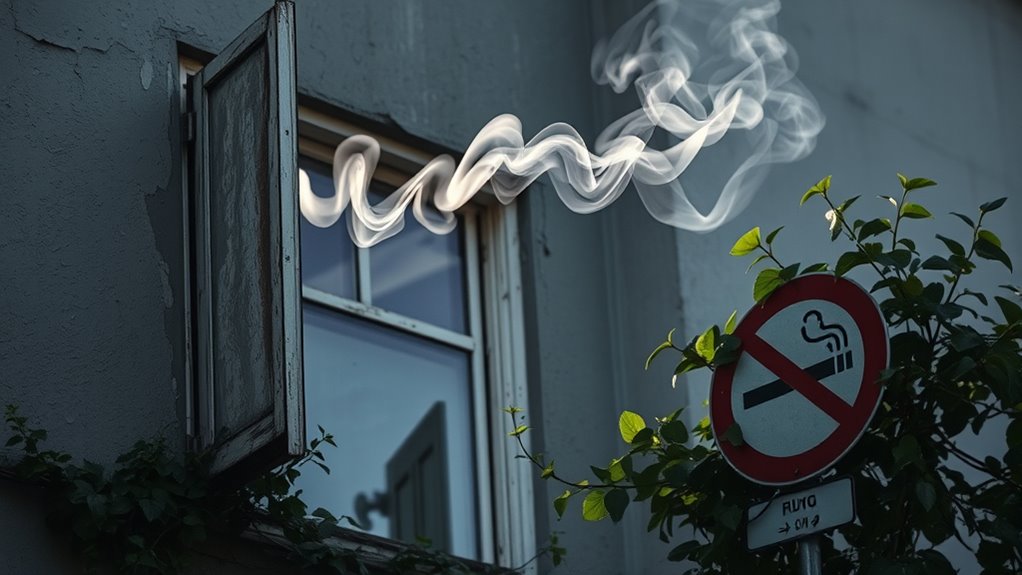To address secondhand smoke in multi-unit housing, start with implementing a strict smoke-free policy that covers indoor and shared spaces, and clearly communicate it to residents. Complement this with physical measures like installing air filtration systems and improving ventilation to reduce smoke infiltration. Outdoor smoking areas placed away from entrances also help. Combining these strategies creates healthier living environments. To learn more about effective solutions and community cooperation, keep exploring how you can make these steps work for your space.
Key Takeaways
- Implement and enforce comprehensive smoke-free policies throughout all indoor areas and shared spaces.
- Educate residents about health risks and benefits of smoke-free living to encourage cooperation.
- Use air filtration systems like HEPA purifiers in individual units and common areas to reduce smoke particles.
- Design outdoor smoking areas away from windows, entrances, and ventilation systems to prevent smoke infiltration.
- Foster collaboration between residents and management to create a healthier, smoke-free multi-unit housing environment.

Secondhand smoke poses a vital health risk for residents of multi-unit housing, where smoke from one unit can easily drift into neighboring apartments. If you live in such a setting, you might notice how cigarette or tobacco smoke infiltrates your space even when no one is smoking nearby. This pervasive issue affects everyone’s health, especially those with respiratory problems, children, and the elderly. Addressing this problem requires proactive measures, including implementing effective air filtration systems and adopting extensive smoke-free policies.
Air filtration plays an essential role in reducing indoor air pollutants caused by secondhand smoke. High-efficiency particulate air (HEPA) filters can capture tiny smoke particles, improving air quality inside your apartment or building. Installing portable air purifiers in common areas and individual units helps mitigate smoke infiltration and creates a cleaner environment. However, relying solely on air filtration isn’t enough. While these devices can considerably reduce airborne contaminants, they don’t eliminate the source of the smoke. That’s why building management and residents need to work together to establish and enforce smoke-free policies.
Air filtration reduces smoke particles but must be combined with smoke-free policies for effective protection.
Smoke-free policies are the most effective way to prevent secondhand smoke exposure in multi-unit housing. These policies prohibit smoking inside individual units, shared hallways, stairwells, and common areas. Implementing such policies requires clear communication, resident cooperation, and sometimes, legal agreements. When residents understand the health risks associated with secondhand smoke, they’re more likely to support and adhere to these policies. Many housing communities have successfully adopted smoke-free policies by providing resources for smokers, such as cessation programs, and highlighting the benefits of healthier living environments for all residents.
Enforcing smoke-free policies also involves addressing challenges like residents who smoke privately but still produce smoke that drifts into neighboring units. Building management can install physical barriers, improve ventilation systems, or designate specific outdoor areas for smoking far away from windows and entrances. Combining these strategies with air filtration systems enhances overall effectiveness, creating a multi-layered approach to reduce smoke infiltration. Recognizing the importance of building design can further help in minimizing smoke spread and improving indoor air quality.
Ultimately, tackling secondhand smoke in multi-unit housing requires a commitment from both residents and management. By prioritizing smoke-free policies and utilizing air filtration techniques, you can greatly improve indoor air quality and protect everyone’s health. Creating a smoke-free environment benefits not only individual residents but also fosters a healthier, more comfortable community. Your proactive steps can make a real difference in reducing exposure and promoting the well-being of all who live and work in these shared spaces.
Frequently Asked Questions
Are There Legal Restrictions on Banning Smoking in Multi-Unit Housing?
You can ban smoking in your multi-unit housing, but legal exemptions and lease clauses may limit your options. Landlords often include specific lease clauses to restrict smoking, yet some jurisdictions have legal exemptions protecting tenants’ rights. Check local laws to understand restrictions, and make sure your lease clearly states no-smoking policies. This proactive approach helps reduce secondhand smoke exposure while respecting legal boundaries and tenant rights.
How Can Residents Effectively Communicate About Secondhand Smoke Concerns?
Think of your voice as a beacon shining through the fog. You can raise awareness about secondhand smoke by using clear, respectful communication strategies. Share your concerns with neighbors and property managers, and keep records of incidents. Being proactive and courteous helps build tenant awareness and fosters understanding. Your voice can clear the air, creating a healthier environment where everyone feels heard and respected.
What Are the Health Impacts of Secondhand Smoke Exposure?
You should be aware that secondhand smoke poses serious health risks, including respiratory issues, cardiovascular disease, and increased cancer risk. Exposure can also facilitate disease transmission, especially in shared spaces. Even brief contact can harm your health over time. To protect yourself, avoid smoky environments and advocate for smoke-free policies in your housing. Your awareness and action can considerably reduce your risk of these health problems.
Can Landlords Implement Smoke-Free Policies Without Tenant Consent?
Yes, landlords can implement smoke-free policies without tenant consent by making lease modifications, provided they follow local laws and tenant rights. While tenants might object, emphasizing the health benefits and improved living conditions can help. You should communicate clearly and update lease agreements accordingly. This approach promotes a healthier environment for all residents and respects your rights while balancing safety and comfort in your housing.
Are There Financial Incentives for Property Owners to Go Smoke-Free?
Yes, you can find financial benefits in making your property smoke-free. Going smoke-free reduces maintenance costs by preventing smoke damage, stains, and the need for frequent cleaning. It also lowers your liability for health-related issues and potential legal costs. Additionally, smoke-free policies can attract healthier tenants, reducing turnover and vacancy rates, which ultimately boosts your property’s profitability. These financial incentives make switching to a smoke-free environment a smart choice for property owners.
Conclusion
You now know how secondhand smoke affects everyone in multi-unit housing, with over 80% of residents exposed at some point. It’s clear that creating smoke-free policies benefits all tenants’ health and comfort. By supporting these initiatives, you help protect your neighbors and improve your living environment. Remember, small actions can lead to big changes—together, you can make your community healthier and safer for everyone.










